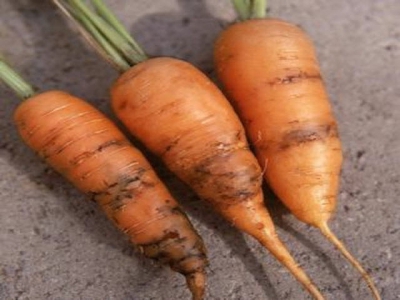Pests and Diseases of Carrots, Parsley and Parsnips

Pests, Diseases and Problems of Vegetables (Brassicas and related crops)
Carrots, Parsley and Parsnips
The following may attack all three crops unless otherwise stated.
Carrot root fly (Psila rosea)
Typical symptoms: Seedlings may fail to grow. On older plants, leaves may show red or yellow colouring and growth may be stunted. Often the only symptom on carrots is the surface tunnelling of the roots; small white larvae may be seen in these tunnels.
Prevention and treatment: Once a crop is infected nothing can be done about it. The most successful method of avoiding attack is to grow the crop under a cover or to sow to avoid the main egg-laying period of the fly, that is, early (late winter to early spring) or late (early summer). Other methods include growing on a windy site intercropping with onions (see Organic Gardening – Preventing Problems (Companion Planting)) and growing within a carrot root fly barrier (see Garden Pests and Diseases – Barriers and Traps). Use a crop rotation and winter-dig where carrot root fly has been a problem. Sow seed thinly to avoid the need for thinning out later. (See also Organic Gardening – Preventing Problems)
Carrot willow aphid (Cavariella aegopodii)
Typical symptoms: Carrot leaves are infested with small green aphids.
Prevention and treatment: See Aphids as Garden Pests
Parsnip canker (various fungi)
This disease affects parsnips only.
Typical symptoms: Small brown spots appear on leaves; the roots develop orange-brown patches on the “shoulder”.
Prevention and treatment: Grow resistant varieties of vegetables. Use a crop rotation and drain or avoid wet soils. Small roots produced by using a spacing of approximately 7.5-10cm (3-4in), are less prone to canker.
Splitting
Typical symptoms: Roots split.
Prevention and treatment: See Plant Disorders – Understanding the Problem
Violet root rot (Helicobasidium brebissonii)
Typical symptoms: A network of purple strands appear on roots; root tissues are affected by brownish rot. Above ground plants may become stunted or yellowed.
Prevention and treatment: See How to Treat Common Plant Diseases
Related news
 How to grow cordon tomatoes
How to grow cordon tomatoes Get advice on growing cordon tomatoes, including tips on pinching out sideshoots, watering and feeding.
 Early pest management for tomatoes
Early pest management for tomatoes The first consideration for those who plant in the soil is the threat of soil insects, especially cutworms.
 Fertilising tomatoes after planting
Fertilising tomatoes after planting When it comes to fertilising tomatoes after planting, much will depend on what fertiliser you used in the pre-planting stages and the condition of the soil.